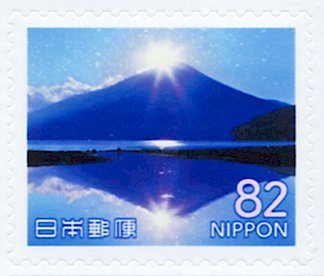Stamp: Sun over Mt Fuji (Japan 2018)
Sun over Mt Fuji (Japan 2018)
02 March (Japan ) within release My Journey Stamp Series 3 goes into circulation Stamp Sun over Mt Fuji face value 82 Japanese yen
| Stamp Sun over Mt Fuji in catalogues | |
|---|---|
| Michel: | Mi: JP 9005 |
| Sakura: | Sak: JP C2354h |
Stamp is horizontal format.
Also in the issue My Journey Stamp Series 3:
- Stamp - Waterfall face value 62;
- Stamp - Swan Ship on Lake, Mt Fuji face value 82;
- Stamp - Torii and Mt Fuji face value 62;
- Stamp - Nagoya Castle face value 62;
- Stamp - Hot Spring and Mt Fuji face value 82;
- Stamp - Peach Blossoms face value 82;
- Stamp - Moss Phlox (Phlox subulata), Mt Fuji face value 82;
- Stamp - Grapes face value 82;
- Stamp - Sun over Mt Fuji face value 82;
- Stamp - Bullet Train, Mt Fuji face value 62;
- Stamp - Tea Fields, Mt Fuji face value 62;
- Stamp - Cherry Trees and Mt Fuji face value 82;
- Stamp - Pine Tree and Mr Fuji face value 62;
- Stamp - Cherry Tree, Mt Fuji face value 62;
- Stamp - Wine and Glasses, Mt Fuji face value 82;
- Stamp - Cattle on Plateau, Mt Fuji face value 62;
- Stamp - Shinto Shrine face value 62;
- Stamp - Tea and a Sweet face value 62;
- Stamp - Peach Trees and Mt Fuji face value 82;
- Stamp - Pond and Mt Fuji face value 82;
- Stamp - Hot Spring and Mt Fuji face value 82;
- Stamp - Mt Fuji with Flowers face value 62;
- Stamp - Moss Phlox (Phlox subulata), Mt Fuji face value 82;
- Stamp - Waterfall face value 62;
- Stamp - Mt Fuji with Trees face value 62;
- Stamp - Peach Blossoms face value 82;
- Stamp - Nagoya Castle face value 62;
- Stamp - Mt Fuji with Clouds face value 82;
- Stamp - Mt Fuji with Clouds face value 120;
- Stamp - Swan Ship on Lake, Mt Fuji face value 82;
- Stamp - Torii and Mt Fuji face value 62;
- Stamp - Mt Fuji with Clouds face value 82;
Stamp Sun over Mt Fuji it reflects the thematic directions:
A landscape is the visible features of an area of land, its landforms and how they integrate with natural or man-made features. A landscape includes the physical elements of geophysically defined landforms such as (ice-capped) mountains, hills, water bodies such as rivers, lakes, ponds and the sea, living elements of land cover including indigenous vegetation, human elements including different forms of land use, buildings and structures, and transitory elements such as lighting and weather conditions. Combining both their physical origins and the cultural overlay of human presence, often created over millennia, landscapes reflect a living synthesis of people and place that is vital to local and national identity. The character of a landscape helps define the self-image of the people who inhabit it and a sense of place that differentiates one region from other regions. It is the dynamic backdrop to people’s lives. Landscape can be as varied as farmland, a landscape park, or wilderness. The earth has a vast range of landscapes, including the icy landscapes of polar regions, mountainous landscapes, vast arid desert landscapes, islands and coastal landscapes, densely forested or wooded landscapes including past boreal forests and tropical rainforests, and agricultural landscapes of temperate and tropical regions.
The Sun, also known as Sol, is a star at the center of the solar system. It is a white star that gives off different types of energy such as infrared energy (heat), ultraviolet light, radio waves and light. It also gives off a stream of particles, which reaches Earth as "solar wind". The source of all this energy is nuclear fusion. Nuclear fusion is the reaction in the star which turns hydrogen into helium and makes huge amounts of energy. It is a nearly perfect ball of hot plasma.
Tourism is travel for pleasure or business; also the theory and practice of touring, the business of attracting, accommodating, and entertaining tourists, and the business of operating tours. Tourism may be international, or within the traveller's country. The World Tourism Organization defines tourism more generally, in terms which go "beyond the common perception of tourism as being limited to holiday activity only", as people "traveling to and staying in places outside their usual environment for not more than one consecutive year for leisure, business and other purposes". Tourism can be domestic or international, and international tourism has both incoming and outgoing implications on a country's balance of payments. Today, tourism is a major source of income for many countries, and affects the economy of both the source and host countries, in some cases being of vital importance.
The United Nations Educational, Scientific and Cultural Organization (UNESCO; pronounced /juːˈnɛskoʊ/) is a specialized agency of the United Nations (UN) with the aim of promoting world peace and security through international cooperation in education, arts, sciences and culture. It has 194 member states and 12 associate members,as well as partners in the non-governmental, intergovernmental and private sector. Headquartered in Paris, France, UNESCO has 53 regional field offices and 199 national commissions




